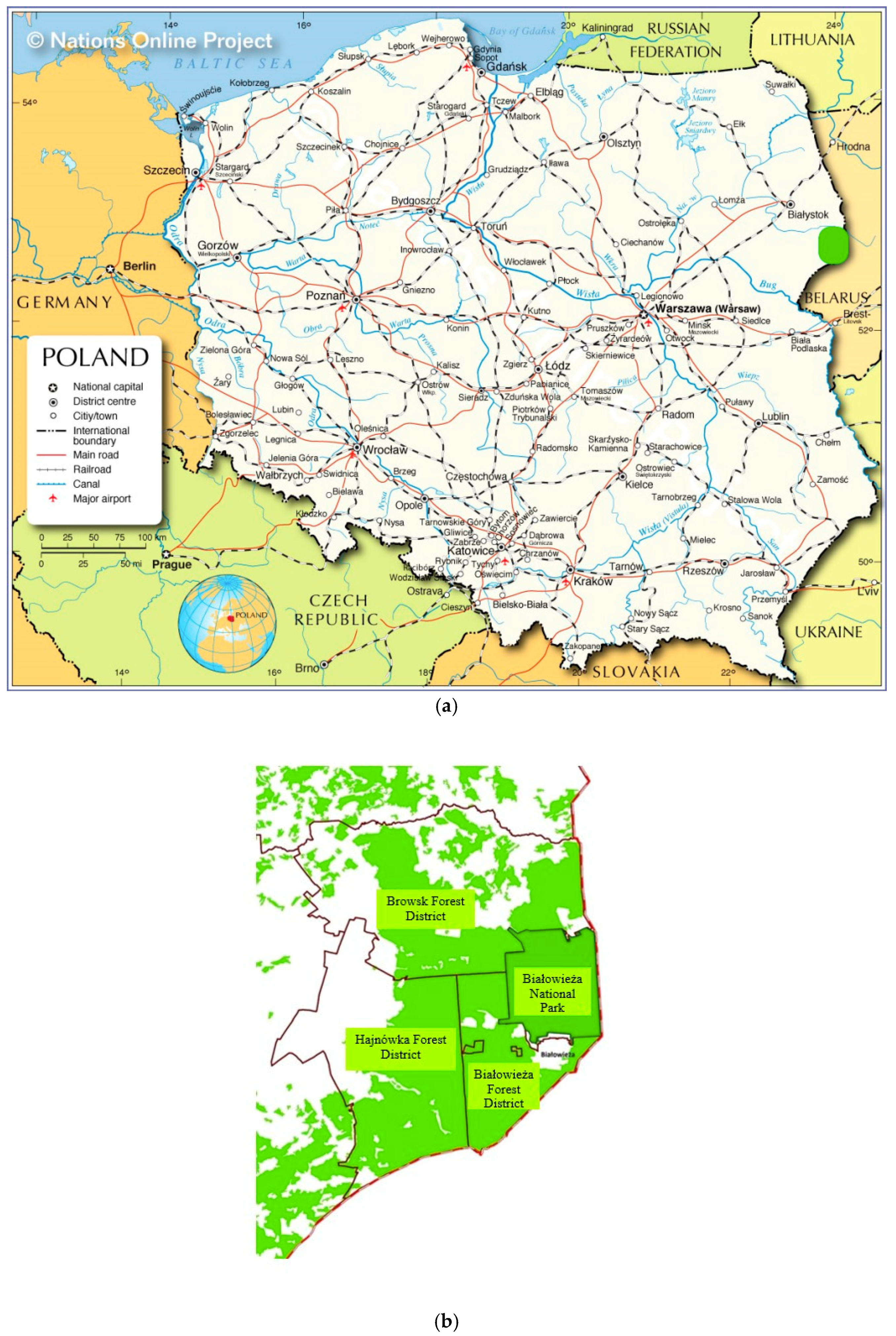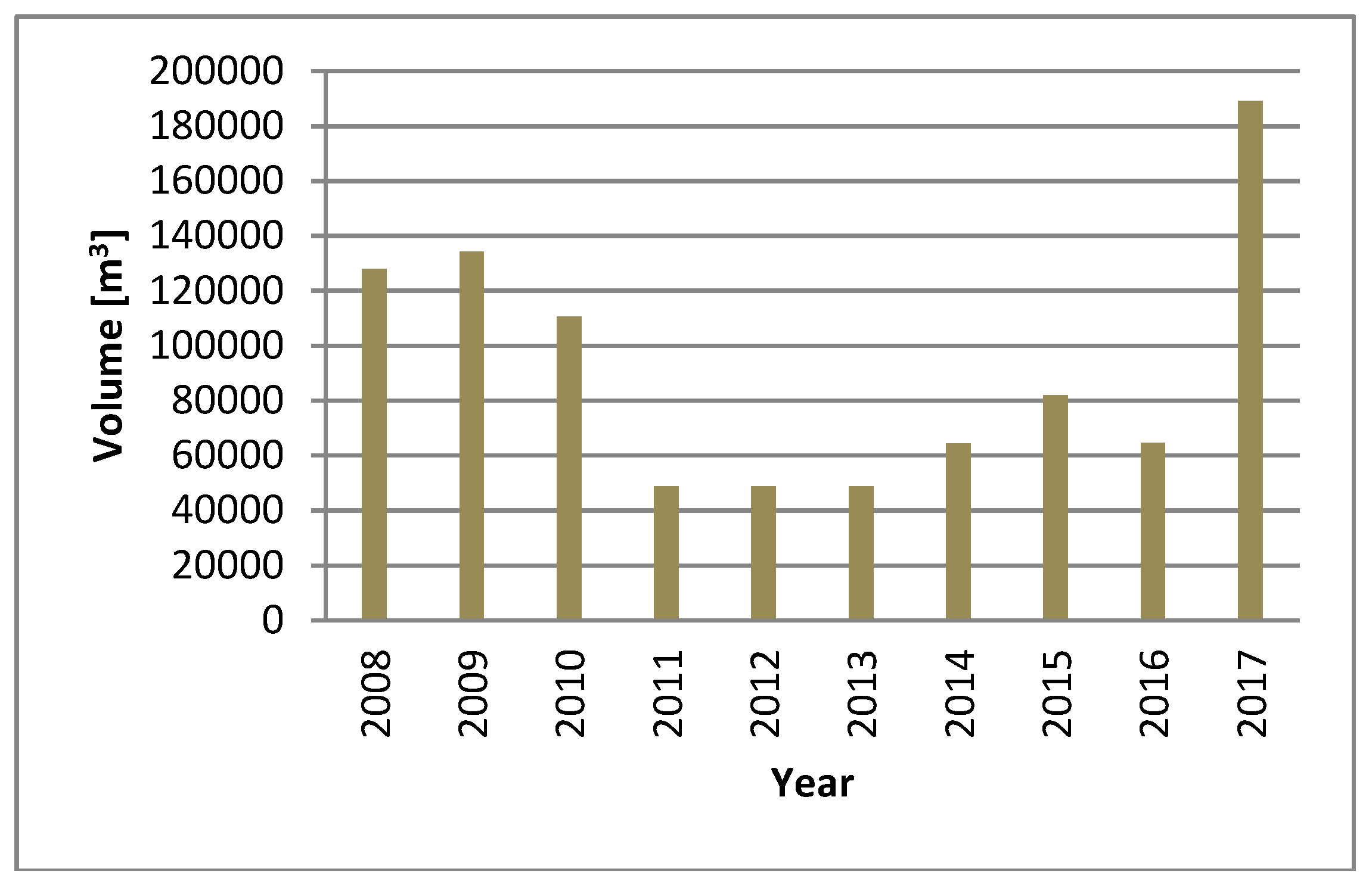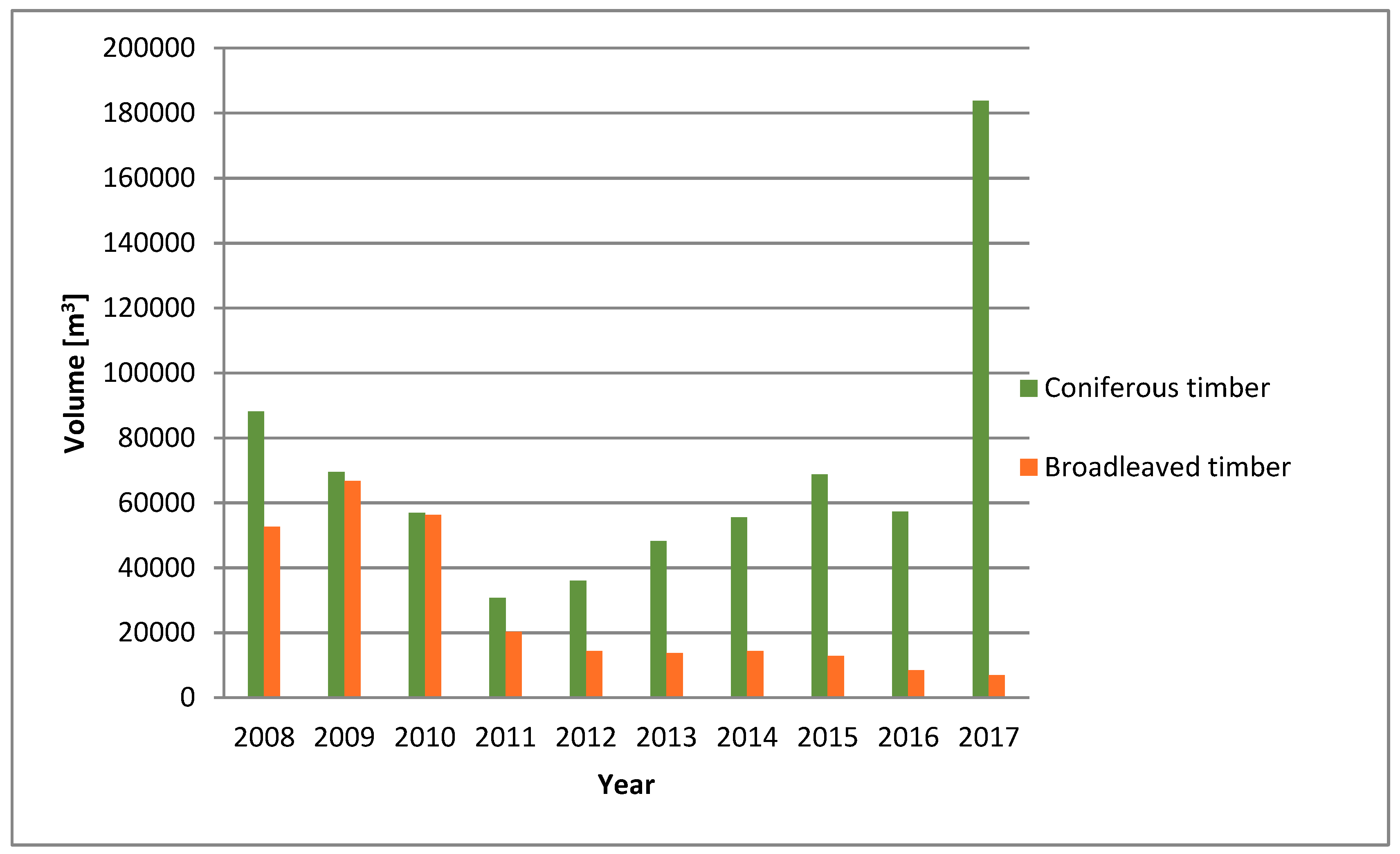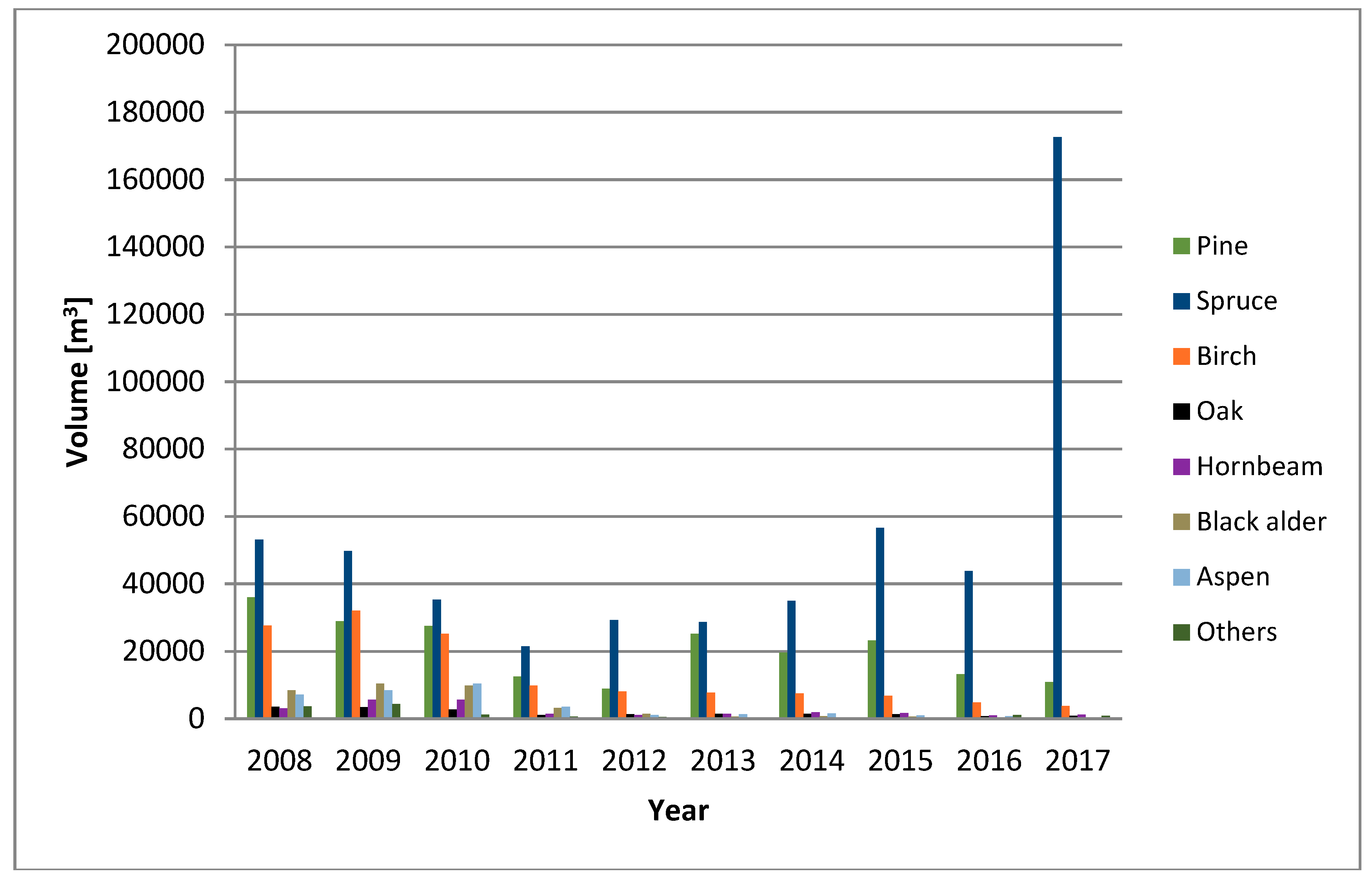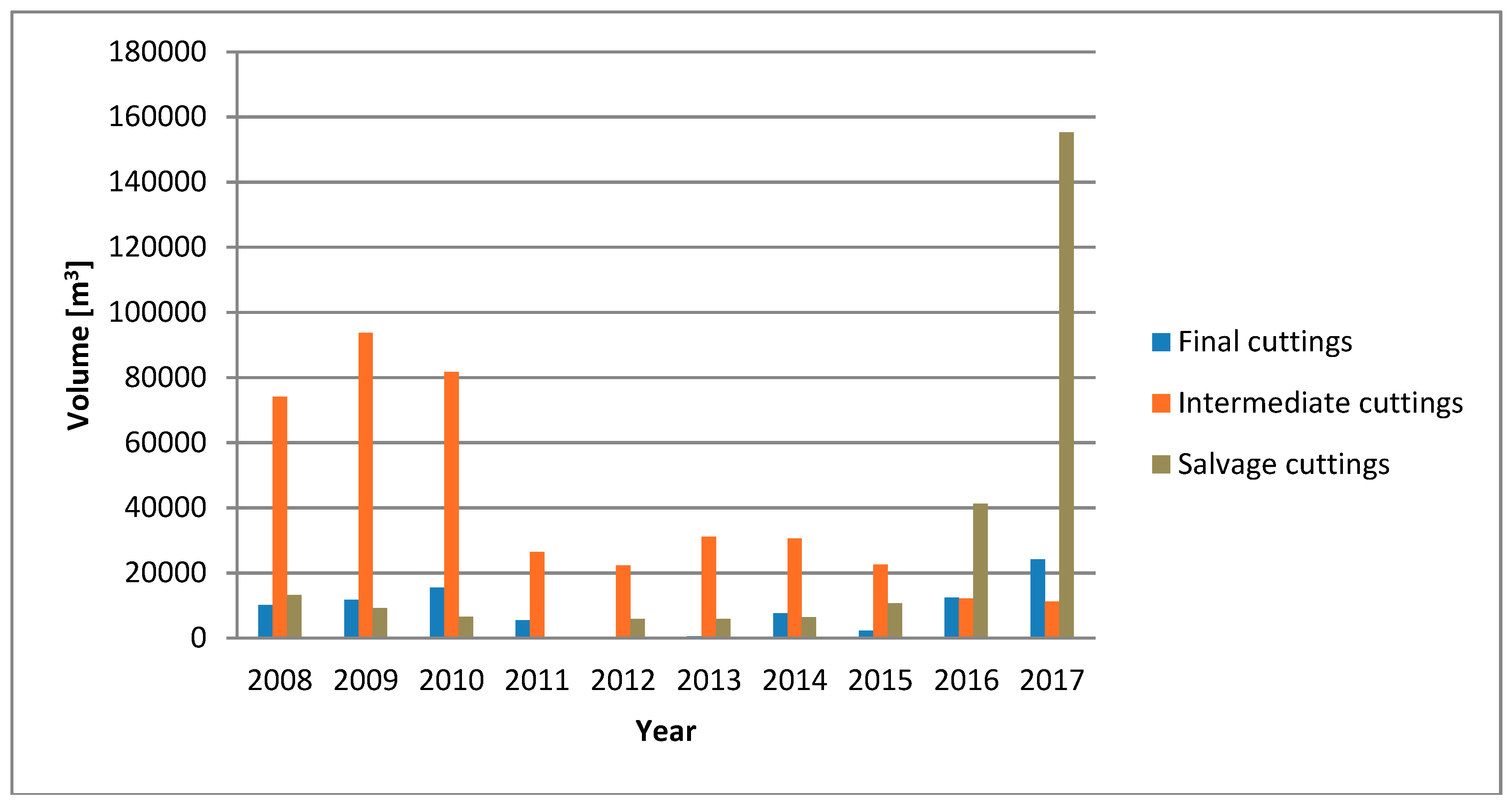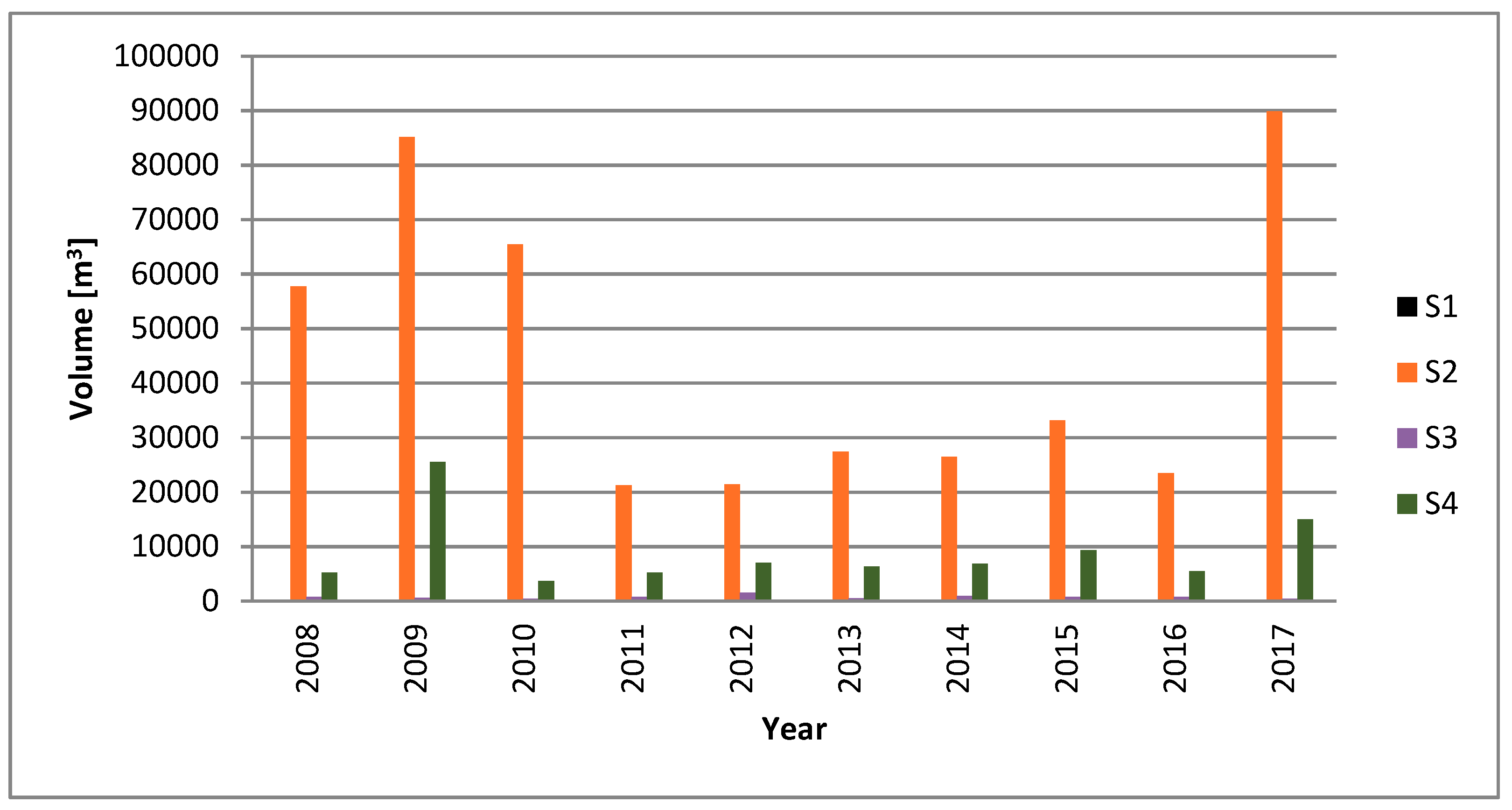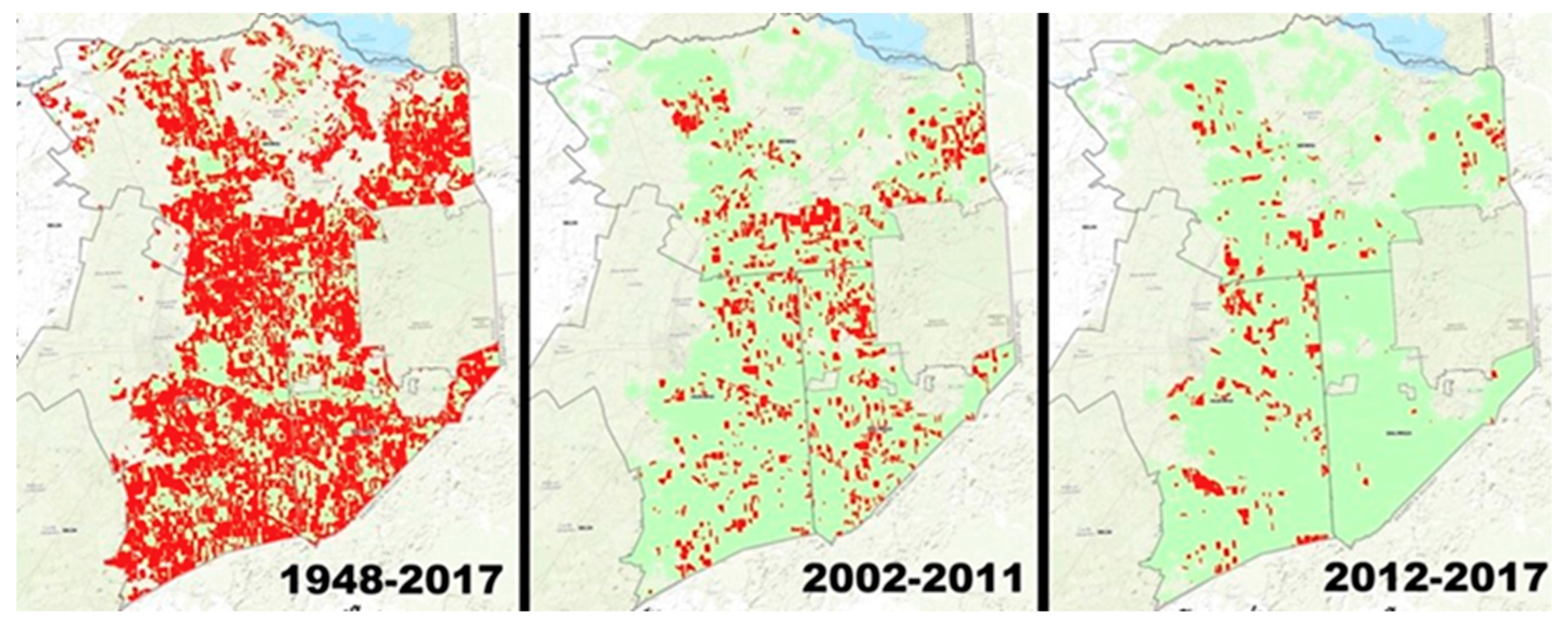1. Introduction
Using forests is an inseparable part of active nature conservation. This applies to commonly managed areas, as well as to areas under various forms of protection. In Poland, this also applies to forested areas located within national parks, from which, in the form of sanitation cuts, an average of about 190,000 m
3 of wood raw material is obtained annually [
1].
Currently, all activities of Polish forestry practice are based on the principles of sustainable forest management. According to the Act on Forests of 1997, Art. 6.2., this is understood as those actions aimed at shaping the structure of forests and the manner and pace of their use, which ensures the continuation of biological richness, regenerative potential, and high productivity, as well as the fulfilment of all the functions of a forest, i.e., conservation, social, and economic functions, without harming neighboring ecosystems [
2].
Białowieża Forest (BF) is an exceptionally valuable forest complex located in Poland and Belarus, characterized by great natural and historical features. It is unique by being the only European lowland primeval deciduous and mixed forest within its boundaries [
3]. Some maintain, however, that the present forest is the result of human activity [
4]. BF also plays a key role from the point of view of regional development and the welfare of the local community [
5].
The concentration of natural wealth within the forest results, among others, from the fact that by the 15th and 16th centuries it formed one large forest complexes together with other forests: Świsłocka, Bielska, Błudowska, Ladzka, and Kamieniecka. The great interest in these areas of Lithuanian princes, Polish kings, and Russian tsars, led to the emergence of many forms of nature conservation, which proved to be crucial for successful hunting. The area was also difficult to access due to peat and bog forests in the region, contributing to its protection. All these factors made it possible to avoid forest fragmentation and extensive logging [
6,
7,
8].
Wood has been harvested from BF in an organized manner, since the beginning of the 15th century. At that time, wood intended for the construction of ships was rafted to the Baltic Sea. Laws on the exploitation of timber were first instituted in the 16th century. They governed the production of barrel staves, ash, and tar. Forest use was mainly based on leases. In 1821, felling from the entire forest was banned. This was ruled by Tsar Alexander I because of the bison living there [
9].
Very intensive exploitation of the forest began in 1915, when tsarist troops entered Białowieża, with large scale logging taking place at that time. The largest plant in Europe for the dry distillation of wood was built in Hajnówka. A wood wool factory was established, as well as a factory producing wooden elements used to build houses. Logs were transported on a 130 km narrow-gauge railway network, built specifically for the export of wood [
10].
The harvesting of wood raw material resources on an industrial scale from BF began during World War I, with the wanton exploitation by foreign occupiers of more than 4 million m
3 of mainly oak and ash wood, with 6500 ha of clear cuts [
11].
Further timber logging in this area took place in 1924 when the government, which had a large budget deficit, issued a permit for the felling of trees from the Białowieża forests to the European Century Timber Corporation. The company was to acquire 325,000 m
3 of wood annually, for the next decade. The wood was obtained mainly from clear cuts, leaving only seedlings. After a period of five years, Polish foresters interceded on behalf of BF and forced the government to break the contract, requiring the State Forests to pay a compensation. Before this happened, the company managed to acquire another approximately 2.5 million m
3 of wood. In 1919–1923, the Polish forestry administration harvested about 1.5 million m
3 of timber. The amount of timber harvested from 1915 to 1924 in the area of the forest amounted to approximately 9 million m
3 [
12].
After this earlier harvesting, a significant share of birch and aspen forests, as well as spruce and pine monocultures of about 80 years of age remained, replacing 100 ha of clear cuts. In 1938, the director of the Regional Directorate of State Forests in Białowieża issued an ordinance recommending the use of natural regeneration [
13].
During the Second World War, the Soviet army plundered about 1 million m3 of timber. After the Germans took over the area, Białowieża Primeval Forest was to become the hunting ground for the highest dignitaries of the Third Reich, and therefore these areas were protected. In 1945, Białowieża Forest was divided by the Polish-Soviet border.
In 1945–1946, the use of the Polish part of BF was unorganized and much pillaging occurred. In 1948–1958, an average of 189,000 m³ of wood was harvested annually. The year 1975 was a record year in terms of harvesting, when 212,000 m³ of wood was logged. Logging decreased in the following years, with 168,100 m³ in 1980 [
11]. In the 1990s, logging continued at the level of the 1980s.
At the beginning of the 21st century, planned harvesting was still at 150,000 m³ per year. However, the actual harvest was slightly lower and in 2000–2008, about 125,000 m³ of wood were harvested annually [
14].
Currently, an area of 87,360 ha of the forest in Belarus is fully protected as a national park, whilst the forest areas in Poland are under various, often overlapping forms of nature protection, subject to special legal regulations. Białowieża Forest in Poland covers an area of approximately 63,000 ha, of which 10,500 ha are in Białowieża National Park. The remaining part, about 52,500 ha, is managed by the State Forests National Forest Holding by three Forest Districts: Białowieża, Hajnówka, and Browsk. The situation of Białowieża National Park is less complicated because the Minister of the Environment established its protection plan in 2014. In this part of the forest, no sanitation cutting is conducted.
In 1994, State Forests established the Promotional Forest Complex (LKP)—Białowieża Primeval Forest in the aforementioned Forest Districts, encompassing a total area of approximately 39,500 ha of managed forests and approximately 12,000 ha of reserves excluded from economic use. The aim of the LKP is to manage the forest in a model, enduring, and sustainable manner, and to perform specific tasks relating to nature conservation as defined in the Forest Act of 1991 [
15]. About 70% of the area has been removed from active protection, being replaced by “the protection of ecological processes” or passive (conservation) protection, where no cuts are made. LKP has a management and protection program, established by the regional directorate of the State Forests in Białystok in 2011. The achieved nature conservation goals are based on the Convention on Biological Diversity, adopted at the Earth Summit in Rio de Janeiro in 1992, ratified by Poland in 1995 [
16].
The entire Polish part of Białowieża Forest is a Natura 2000 site. This is due to the EU Birds and Habitats Directives, which together form an area of special protection for habitats and birds. The latest binding protection plan was approved by the Regional Director for Environmental Protection in Białystok in 2015.
Since 2005, the entire forest has been recognized as a Biosphere Reserve, whilst in 2014 it adhered to UNESCO’s World Heritage List, together with the Belarusian part. In 2005, areas of the forest were designated as a Protected Landscape Area by a decree of the Podlasie Voivode [
17].
Supporting and developing the processes of conducting sustainable forest management (SFM) is implemented, among others, through certification [
18,
19]. Forest management certification systems control whether the management and use of forests takes place in the correct manner, also taking into account the needs of forest conservation. In the case of Polish forests, two independently functioning certification systems are particularly important: FSC (Forest Stewardship Council) and PEFC (Programme for the Endorsement of Forest Certification) [
20]. It should be noted that the Forest Districts in Białowieża Forest were certified in the past by both certification systems. However, at the present time, they do not have such certificates: FSC withdrew its certificate in 2010, and PEFC in 2018. Both organizations repeatedly emphasize the European Commission’s thesis that increased logging in these Forest District areas in 2016–2017 was conducted without assessing the impact on the natural condition of Białowieża Forest, thus breaking EU law.
The real problem in implementing the concept of sustainable forestry and forest multifunctionality is an unsolvable difficulty in anticipating the expectations of future generations as to the condition, appearance, and composition of future forests. In forestry practice, all the forest functions can be met only in a very long time horizon, i.e., the calculated life expectancy of trees and stands [
21].
Currently, Białowieża Forest is the center of interest for the Polish government and non-governmental environmental organizations. The subject of the use and management of the BF forests has been controversial for many years, resulting in at local, national, and international levels, especially now, in the face of changes in the species composition of the forest stands and the disastrous infestation of the spruce bark beetle (Ips typographus (L.)), destruction of the spruce stands. In view of these events, the most frequently asked questions are: How was a disaster of such proportions brought about in such a valuable forest complex? Should active forest management be conducted in the managed part of Białowieża Forest?
The purpose of this article is to analyze the size and structure of harvested timber from 2008–2017, in the three Forest Districts located in Białowieża Forest, as well as to show the natural conditions and legal context influencing its commercial management.
2. Materials and Methods
The subject of the research is the Polish managed part of Białowieża Forest. This area consists of three Forest Districts: Białowieża, Browsk, and Hajnówka, located in the north-eastern part of the country (
Figure 1).
The main tree species in this area are Scots pine and spruce, accounting for 56.85%. The share of deciduous species is also significant, i.e., alder 20% and oak 10.75% (
Table 1). These are generally fertile forests. The largest share consists of fresh broadleaved forest, fresh mixed coniferous forest, and fresh mixed broadleaved forest. In total, these habitat types occupy 54.53% of the forests (
Table 2).
The research includes an analysis of the total size and structure of harvested wood in the three Forest Districts. The data for the analysis are from reports generated by the State Forests Information System (SILP) for the Hajnówka, Browsk, and Białowieża Forest Districts. Information from the Forest Management Plans of these districts was also used [
24,
25,
26], as well as their Nature Conservation Programs for 2012–2021. Detailed data on harvesting wood was transferred and processed in Excel. To present the scale of the problem for the entire analyzed area, we did not calculate the values for individual forest districts.
Forest Management Plans in Poland are drawn up for a ten-year period. In the case of the analyzed Forest Districts, the current plan covers the period from 2012–2021. This document was prepared by external experts, consulted with various communities, and finally approved by the Minister of the Environment. The annual allowable cut of the aforementioned Forest Districts determines the amount of timber to be harvested in subsequent years covered by the plan.
The analyses includes:
the total amount of harvested timber,
the amount of harvested timber by tree species,
the amount of harvested timber by assortment groups,
the amount of harvested timber by cutting categories.
The basis for the quality and dimensional classification are the standards in force in Poland, and the technical conditions issued by directives of the General Directorate of State Forests. They categorize particular timber assortments according to classification by quality and dimension [
1].
The total volume of the removed wood consists of: Merchantable timber (large timber), slash, and stump wood. The timber includes large-size and medium-size round wood.
Large-size wood (L), is wood with a thin end diameter of 14 cm (excluding bark), calculated in single pieces. In terms of quality and size, large-size wood is divided into four classes: WA, WB, WC, WD and into 2 sub-classes: general purpose wood (0) and special purpose wood (1). The large-size general purpose wood is comparable to the assortment defined as sawmill wood. The large-size special purpose wood refers to wood classified as commercially-valuable assortment, such as veneer, plywood, matchwood, electrical poles.
Medium-size wood (M), is wood with a minimum diameter of 5 cm and more (excluding bark), with a thick end diameter of up to 24 cm, calculated in single pieces, in pieces as groups, and in stakes. In terms of quality and size, medium-size wood is divided into four groups:
S1–timber wood; this group includes assortments classified according to its purpose as pitwood and wood for building props,
S2–stake wood for industrial processing (inter alia, pulpwood),
S3–round wood for industrial processing (perches),
S4–firewood.
Slash (S), is round wood with a maximum diameter of up to 5 cm (excluding bark).
The PN-D-9500: 2002 standard was used when measuring and calculating wood volume [
27].
3. Results
A total of 918,885.26 m
3 of wood was harvested from the forest areas managed by the State Forests during the analyzed years (2008–2017), resulting in 99,890 m
3 being harvested annually. However, as shown in
Figure 2, the harvested volume differed significantly year by year. From 2008–2009, approximately 130,000 m
3 of wood was harvested each year. A clearly visible decline was observed for 2009–2011, then the harvested volume was mostly constant until 2013, and then it increased again. This was due to the fact that the Minister of the Environment, taking into account the positions of environmental groups and the Council of Europe, changed the management practices of the forests, limiting timber harvesting from 110,000 m
3 in 2010 to 48,500 m
3 in the following years.
It should be noted that ¼ of the stands of this area are spruce stands (
Table 1). For over a decade, practically all of Europe has been affected by spruce bark beetle infestations, including the area under analysis. In the period from 1992–2007, the average volume of spruce killed by this insect in BF amounted to an average of 20,000 m
3 annually. During this period, practically all dead trees were removed from the forest by means of salvage logging [
5]. The reduction in timber harvesting since 2011 has contributed to the intensification of the pest gradation, and the mass extinction of spruce stands. In 2017, the intensive cutting of mostly dead trees commenced, reaching a level of 189,200 m
3.
Among the harvested raw material, coniferous wood has predominated in recent years. In 2017, it constituted as much as 96.39% (
Figure 3) of harvested timber. This is, of course, due to the fact that mainly spruce infested trees by the spruce bark beetle were cut. Of this species, 172,500 m
3 was harvested (
Figure 4). Before the gradation, especially during 2009–2010, the share of harvested coniferous and deciduous wood was at a similar level.
In the analyzed period, the harvesting of broadleaved species was significantly reduced (
Figure 4). From 2008–2010, approximately 52,000–66,000 m
3 of such timber was harvested. A significant reduction in harvests has been observed since 2011 (20,300 m
3), reaching a level of 6900 m
3 in 2017. Birch was primarily harvested, constituting 46 to 60% of the broadleaved species, depending on the year. The trends in harvesting other species have also changed. The percentage share of oak and hornbeam wood increased from around 5 to 13% and 16%, respectively; an opposite trend was observed for aspen, and especially for black alder, for which harvesting was almost halted. In 2017, only 172 m
3 of this species were extracted.
From 2008–2015, wood was harvested in the analyzed area mainly by intermediate cuttings (
Figure 5), for the purpose of improving stand development. Salvage cuttings have been mainly used in the last two years, especially in spruce stands.
From the 1960s to 2015, most of the work of harvesting operations were carried out using chain saws. In 2016, harvesters were introduced in the area of Białowieża Forest for the first time. Non-governmental environmental organizations reacted to this very negatively.
Figure 6 shows the share of harvested wood by specific dimensional groups. Up to 2013, the share of large-size timber was at the level of 30–38%. In following years, this type of assortment increased, reaching 53% in 2016. This was obviously related to the increased harvesting of mature spruce trees infested by the spruce bark beetle. Opposite trends were observed in the case of medium-size wood, which at the beginning of the analyzed period gained slightly more of a share than in the period of 2014–2017. The share of small-size timber generally did not exceed 3.5%.
When analyzing the harvesting of large-size wood, the constant growth of the worst grade of wood, WD quality, should be noted (
Figure 7). Its share during 2008–2011, ranged from 17.9 to 32.9%. In the following years, wood of this quality-dimension class increased significantly up to a level of 90.9% in 2017. This wood was mainly from dead spruces. The average price of this type of raw material was clearly lower than the average sale price of wood, calculated for all assortments harvested in Poland. For example, in 2015, the price of PLN 91.80/m
3 (21.54 €/m
3) was obtained, with the national average for all assortments set at PLN 191.77 (45 €) for 1 m
3. This undoubtedly affected the cost effectiveness of harvesting such timber. It is worth noting that the costs of timber harvesting and extraction amounted, on average, to 64.4 PLN/m
3 (15.11 €/m
3).
At the moment, there are hardly any valuable assortments (i.e., WA and WB) being logged. Their share in 2008–2011 was from 20% to slightly over 35%. It was also sold during special submissions organized by the Regional Forest Directorate [
28,
29].
When analyzing the volume of harvested medium-size timber (
Figure 8), the share of the S2 wood category intended for industrial purposes (industrial stacked wood) was clearly visible. It ranged from 21,287 m
3 (77.9%) in 2011 to 89,824 m
3 (85.4%) in 2017, with fuel wood (S4) making up the rest to 100%. The quality of this assortment was not suitable for industrial production due to its defects. It was primarily intended for heating purposes, therefore it was sold to the local community.
4. Discussion
Polish forests are the richest and best preserved plant formations in the country and among the best preserved in Europe. However, increasing pressure from society is directed towards effective forest protection, which manifests itself in the establishment of nature conservation areas and influences the certification systems of forest management.
Given the information on the history of human impact on the ecosystems of Białowieża Forest, the claim that it is “the last primeval forest in the lowlands of Europe” is not true. It is not a “primary forest” nor a “fully natural forest”, but it does have biocenoses similar to natural ones. The vast majority of the present forest tree stands are the result of human activity. As a result of the consistent work of generations of foresters, the average stock of tree stands increased from 187 m
3/ha in 1930 to 340 m
3/ha today [
4].
Most of BF has been shaped by people for centuries. Fragments of natural forests occupy about 20% of its area and no forestry work is performed in those areas. The rest of the forest is multifunctional, where the greatest emphasis is placed on nature conservation. In the past, foresters’ activities were conducted in those fragments planted by humans, where forest management activities have been conducted for years or which should be transformed, so that the stand structure better suits the conditions of a given area.
Figure 9 illustrates the scope of total cuts conducted in the analyzed Forest Districts, covering the 1948–2017 period. All areas where work was conducted are marked in red. The total share of these areas is significant. At the same time, the significant decrease in the number of harvesting sites is clearly visible [
30].
The diverse sizes of the harvesting sites are due to the numerous restrictions banning logging in stands of 100 years of age or older. Harvesting sites will play an even smaller role in providing raw wood material in successive years, due to the further aging of the forest stands and the deteriorating health condition of the forest. The restrictions introduced on logging timber in moist habitats will significantly reduce the share of raw material from such species as alder, ash, and maple. In addition, the abovementioned ban on logging in 100-year-old stands will significantly reduce the harvesting of oaks and ash trees. This will eliminate veneer wood and the remaining large-scale assortments harvested from these trees from local suppliers.
In recent years, the administration of the Polish managed part of BF has been very complicated and fraught with many difficulties. The main factors relating to this are considered to be the intensity of the timber harvesting, and the complete exclusion of areas of old tree stands from use. Twenty-three international documents (including six from the EU) and 28 Polish legal documents apply to the forest. They pertain to Białowieża National Park, protected landscape areas, nature reserves, nature monuments, ecological use areas, species protection of plants, fungi and animals, NATURA 2000 areas, and the UNESCO World Heritage Site. With such a complicated legal framework, it is extremely difficult for the forest services to make rational decisions [
5].
The management of Forest Districts is primarily regulated by the Forest Management Plan. During the years of 2002–2011, the Forest Management Plan of the Forest Districts of Białowieża Forest determined an annual harvesting amount of 150,000 m
3/year. According to non-governmental environmental organizations, many cases relating to the forest management of these areas contributed to the destruction of habitats of protected species of flora and fauna. The Council of Europe also expressed its concern. Assurances from the State Forests regarding the propriety of activities undertaken to protect BF areas were rejected. The Minister of the Environment, concerned about the situation, changed the management policies of BF areas in 2012, limiting timber harvesting to 48,500 m
3/year [
31]. In addition, stands located in moist habitats and with trees over 100 years old (classified as such based on forestry plots having at least 10% of trees over 100 years of age), were placed under additional protective status. This solution was recognized by the Minister of the Environment and the European Commission, scientific institutions and non-governmental organizations as a compromise resulting from the need to protect nature and provide a certain amount of timber for the needs of the local community.
Due to the great number of spruce trees, problems with bark beetle gradations have systematically occurred in the last hundred years [
32,
33]. In accordance with the Forest Act, foresters are responsible for protecting the forest, including detecting and combating insects endangering the forests. The only method of fighting the spruce bark beetle known by foresters is to remove the infested trees before the insect spreads to another tree [
30]. However, there are scientists with a different opinion, who state that no cuts should be made because the surviving trees are likely better adapted to cope with the beetle, as resistance to herbivores is genetic [
34]. Now, a new generation of trees with higher resistance has the opportunity to expand into the space vacated by the dead spruces. Other tree species (mainly hornbeam and Norway maple) have already started to grow rapidly in the gaps, facilitating the adaptation of the tree community to climate change [
35].
Until 2007, the majority of infested trees were removed as part of sanitation procedures. After this period, however, a large number of spruce snags were left in the area, contributing to a significant increase of trees infested by this insect. In 2016, the volume of such trees in BF exceeded 480,000 m
3 of wood [
5]. In the same year, the Minister of the Environment decided to increase harvests in the analyzed Forest Districts, which is clearly illustrated in
Figure 9. This was mainly dictated by the need to improve public and fire safety. The harvested wood was of much worse quality, compared to the wood obtained in previous years.
From the 1960s to 2015, most of the work of harvesting operations were carried out using chain saws. In 2016, harvesters and forwarders were introduced in the area of Białowieża Forest for the first time. Non-governmental environmental organizations reacted to this very negatively. According to environmental organizations, the increased harvesting was for commercial purposes and they initiated a blockade of the equipment used by the State Forests. It should be remembered, that the logging is conducted in accordance with the rational planning of silviculture and forestry work, taking into account the protective functions of forests and socio-economic needs, and is an activity that helps in forming stable and sustainable ecosystems [
36].
In 2015, representatives of the government, local governments, Białowieża National Park, State Forests, and the National Fund for Environmental Protection and Water Management signed a letter of intent for an Integrated Program for Białowieża Forest—the forest heritage of Europe. The program was based on the implementation of integrated tourism, recreation, and educational activities, whilst preserving the natural features of the forest. However, in following years, this program was extensively reduced.
During the 41st session of the UNESCO World Heritage Committee in Krakow in July 2017, a resolution was adopted calling on Poland to immediately stop cutting trees. It was indicated that the activities being conducted were a threat to the forest. In the same month, the European Commission brought a case against Poland in the Court of Justice of the European Union, stating that the logging was a serious threat to the integrity of the Natura 2000 site, was not compatible with the protection objectives of Białowieża Forest, and exceeded the means that could be used to ensure sustainable forest use. In November 2017, the EU Court of Justice ordered Poland to immediately terminate the section under penalty of fines. In April 2018, the EU Court of Justice decided that Poland violated EU law when the harvesting in Białowieża Forest was increased. After this decision, the Minister of the Environment overruled the earlier decision that increased the timber harvesting conducted in Białowieża Forest.
In May 2018, the Minister of the Environment appointed a special international team of experts for BF. As announced, it would develop a plan to protect this area. Representatives of environmental organizations were also invited to the team. For now, however, these organizations are distancing themselves from this endeavor. Some of them point out that the team does not include scientists who objected to the decision to increase timber harvesting in the forest, proposing instead to extend the national park. The team will function until 2019, after the next UNESCO session, due to the fact that the issue Białowieża Forest is to be discussed at that session.
It should be emphasized that the Białowieża Forest is an area in which the people living there meet their cultural, social, and economic needs. However, in recent years, management decisions in this area were made without taking the opinion of the local community into account. This area undoubtedly needs special support for activities promoting the sustainable development of the region.
5. Conclusions
The management of Białowieża Forest has become very complicated and difficult in recent years. Numerous legal acts pertaining to this area, mainly concerning nature conservation, limit the intensity of forest use. Nature reserves and reference zones have been created in a large part of this area, in which no forest management activities are conducted.
The volume of wood harvested from this area has been very diverse in recent years. In 2008–2009, approximately 130,000 m3 of wood was harvested annually. A clearly visible decline occurred in 2009–2011. This is because the then Minister of the Environment, taking into account the position of environmental organizations and the Council of Europe, limited timber harvesting from 110,000 m3 in 2010 to 48,500 m3 in 2011–2013.
The gradation of the spruce bark beetle, causing the death of spruce stands, resulted in the decision to increase timber harvesting. In 2017, 189,200 m3 were harvested, which to a large extent (91%) consisted of spruce. In 2018, the Minister of the Environment rescinded the earlier decision to increase tree felling, complying with the ruling of the EU Court of Justice.
When analyzing the quality of large-size wood harvested from this area, it is worth noting the continually increasing share of the worst quality class—WD. Its share from 2008–2011 ranged from 17.9 to 32.9%. In following years, there was a significant increase in the amount of wood of this quality and dimensional class, up to a level of 90.9% in 2017. This wood was mainly from dead spruce trees, which translated to a significant drop in the value of the raw material being sold.
The sustainable development of this region in terms of nature and its culture undoubtedly requires taking the opinions of the local community into account. This also applies to harvesting timber at such a level, so that it is possible to ensure the region’s proper economic development. Therefore, a compromise should be worked out between environmental organizations and the entities managing this unique forest area.
